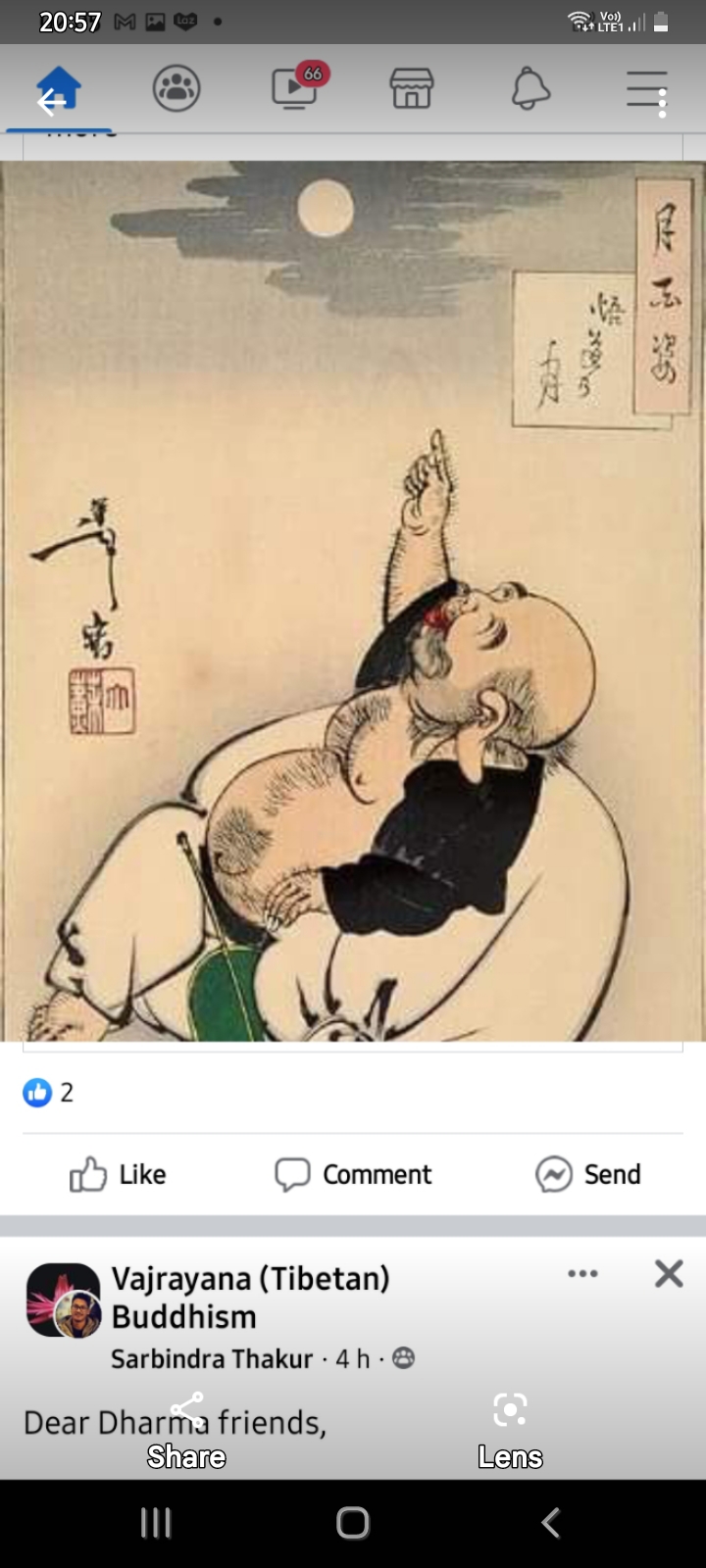-
Content count
10,544 -
Joined
-
Last visited
-
Days Won
100
Everything posted by C T
-

Seeing, Recognising & Maintaining One's Enlightening Potential
C T replied to C T's topic in Buddhist Textual Studies
What is the difference between the real state of rigpa and the imitation? Check whether or not there is any clinging, any sense of keeping hold of something. With conceptual rigpa you notice a sense of trying to keep a state, trying to maintain a state, trying to nurture a state. There is a sense of hope or fear and also a sense of being occupied. Understand? The keeping means there’s a sense of protecting, of not wanting to lose it, in the back of the mind. This is not bad, it’s good, and for some people there’s no way around training like that in the beginning. Through training in this way, that conceptual aspect becomes increasingly refined and clarified. So you practice more, more, more. Now you have more of a sense of openness, but still you’re holding this openness. All right, then, let the openness go. Let’s say that after two months you let it go. But still you’re staying within the openness — so then you practice letting go of the staying. And somehow there is still a remnant of wanting to achieve it again. So you let that go as well, and slowly again let it go, let it go, until you become very much “just there,” and finally very free and easy. ~ Tsoknyi Rinpoche -

Seeing, Recognising & Maintaining One's Enlightening Potential
C T replied to C T's topic in Buddhist Textual Studies
Returning home (to basic wakefulness) is always an inward journey (of wisdom), but with an outward expression (of compassion). ~ P. Ladakh -

Seeing, Recognising & Maintaining One's Enlightening Potential
C T replied to C T's topic in Buddhist Textual Studies
Dear RT.. this is the only Chamtrul Rinpoche that i know of. Thank you for asking. -

Seeing, Recognising & Maintaining One's Enlightening Potential
C T replied to C T's topic in Buddhist Textual Studies
Nothing, absolutely nothing arises without causes and conditions. Whether it’s external phenomena, no matter how small or subtle it may be, or whether it's any mental state that any being experiences, everything, absolutely everything that has ever existed, or has yet to exist, will have arisen out of causes and conditions. Similarly, the moment when the causes and conditions of your own enlightenment are present, you will become a Buddha. In other words, the moment when your two accumulations of merit and wisdom are complete, Buddhahood will naturally arise as the result, and nothing, absolutely nothing can stop this process. ~ Chamtrul Rinpoche -

Seeing, Recognising & Maintaining One's Enlightening Potential
C T replied to C T's topic in Buddhist Textual Studies
Undelineated in any dimension, the Dharmadhātu encompasses the entirety of both experience (representational consciousness) and non-experience (consciousness itself). There is neither any “thing” nor any “non-thing” that falls outside this all-encompassing spaciousness of consciousness. ~ P. Ladakh -
before rebirth, watch Blade Runner after rebirth, watch Blade Runner....
-
warm. shell on. very slowly. that should do the trick
-
try rubbing a hard boiled egg on your left cheek
-
The yearning for spiritual fruition can only be quelled thru expressing gained wisdom, not only by deeds alone, but often, thru knowing refrain and renunciation within the core of one's being. Renunciation is recognising the exact moment when negative emotional triggers are pulled when the mind grasps at something which then creates a reactive spark; seeing immediately its empty nature at once, the spark quickly transforms into bliss! Over time, bliss becomes spontaneous, and work, strife and attention in noticing can, at that point, be let go off. The great masters, out of their limitless kindness, have shown to their beloved spiritual heirs... that at the moment of arising comes the opportune moment for liberation. Such treasures await those who recognise mind essence!
-

Working with higher level subtle beings and spirits
C T replied to Jetsun's topic in General Discussion
I have seen how some of these guys (spirits/entities) work and can recognise their m.o. They are often beguiling, and would often start off as benevolent, along the way, and in varying degrees, their malevolency will surface in accordance to the gradual dissipation of one's spiritual merit and energy. Such 'infestations' are quite common in SE Asia where i grew up and remained for 30 years. Countries like Indonesia, Thailand and Malaysia are especially rife with these kinds of monkeyish critters. -

Working with higher level subtle beings and spirits
C T replied to Jetsun's topic in General Discussion
Its very simple - yidam practice is part of the framework which consists also of lama and khandro (lama, yidam & khandro). An authentic Vajrayana practitioner who undertakes this practice will do it within this complete framework. Its not as if its a 'choose what you like' practice. Any Vajrayana practitioner will know the core purpose and how essential it is to perform the practice in its completeness because this is reflective of what all authentic Vajrayana teachers encourage the students to observe - that is, a practice must be good in the beginning, good in the middle, and good in the end. One cannot simply insist on yidam practice alone. It nullifies the practice completely. It can lead to very dire consequences actually. Just like in the trinity, one cannot say they only want to believe in Jesus and work with that principle alone, and that Father and Holy Spirit is secondary and can be set aside. Its plain foolish to think like that. -
its easy to take something simple and spin it out of its intended premise.
-

Working with higher level subtle beings and spirits
C T replied to Jetsun's topic in General Discussion
One should not attempt to teach French cooking using Asian cookery methods. -

Working with higher level subtle beings and spirits
C T replied to Jetsun's topic in General Discussion
Brian - A most reliable source to aid research http://www.berzinarchives.com/cms/x/s/searchresult.html?path=%2Fen%2F&__locale=en&query=yidams&submit=Search -

Seeing, Recognising & Maintaining One's Enlightening Potential
C T replied to C T's topic in Buddhist Textual Studies
Unless you practise dharma according to the dharma, dharma itself becomes the cause of evil rebirths. — Gampopa -

Working with higher level subtle beings and spirits
C T replied to Jetsun's topic in General Discussion
They are not regarded as bodhisattvas in the context of practice in the lineage i follow. They may all have the necessary qualities of bodhisattva mahasattvas, but again, in the context of practice, Yidams have a wider representation because they also embody the kayas and the omniscience of all the buddhas. Bodhisattvas are basically sons and daughters of buddhas, or some call them buddhas-to-be, which is not very accurate imo. -

Seeing, Recognising & Maintaining One's Enlightening Potential
C T replied to C T's topic in Buddhist Textual Studies
Here, in the thick darkness of deluded ignorance, there shines a vajra chain of awareness, self-arisen with whatever appears. Within uncontrived vividness, unimpeded through the three times, may we arrive at the capital of nondual great bliss. Think of me, think of me; Guru dharmakaya, think of me. ~ Rangjung Rigpe Dorje, 16th Karmapa -

Working with higher level subtle beings and spirits
C T replied to Jetsun's topic in General Discussion
Not only empowerment, but the adherence to pure samaya is necessary if protection is what you seek. At least where Vajrayana Buddhism is concerned. Its not the practice that has the possibility of trickery - its the dabbling practitioner not understanding basic information about what Yidam practices entail - opening him or herself to harm, not by the Yidam but by (i repeat) ignorance. -

Working with higher level subtle beings and spirits
C T replied to Jetsun's topic in General Discussion
Not for a Vajrayana practitioner who adheres to the authentic path. A tutelary deity/Yidam is very specifically invoked as a means to sharpen body, speech and mind thru practice, and draw alignment towards recognising the inseparability of wisdom and compassion, ultimately leading to Buddhahood. Such an approach is unique to Vajrayana Buddhism. In this sense, i'd quite strongly disagree with your loosely formed opinion above. -

Working with higher level subtle beings and spirits
C T replied to Jetsun's topic in General Discussion
The only absolute i can be sure of is the nature of Shunyata inseparable from mind essence. Once recognition (of Shunyata) becomes stable and habitual, there will not be much care for all these other distractions. Then the focus is simply to rest in that recognition often so as to release as much of the remaining subtle karmic residues as possible. This process will hasten faster thru putting certain ethical precepts and compassionate activities in place (like Ngondro for eg.), coupled with periods of insight meditation. -

Seeing, Recognising & Maintaining One's Enlightening Potential
C T replied to C T's topic in Buddhist Textual Studies
to even out some of the oddities that abound? Good -

Seeing, Recognising & Maintaining One's Enlightening Potential
C T replied to C T's topic in Buddhist Textual Studies
posted video this morning at 10.44 am. replied to Brian's post at 10.44 pm. odd -

Seeing, Recognising & Maintaining One's Enlightening Potential
C T replied to C T's topic in Buddhist Textual Studies
I think you are right! -
I dont think energetic practices can be harmful if one has the correct motivation, a primary one being to gain strength so as to be able to genuinely help others by sharing with them one's progressive wisdom and compassion. Then it will always have merit, and will tend to bear fruit quicker. Even the most sublime energetic practice will be poisonous if its solely based on self-centred needs.
-

Seeing, Recognising & Maintaining One's Enlightening Potential
C T replied to C T's topic in Buddhist Textual Studies


